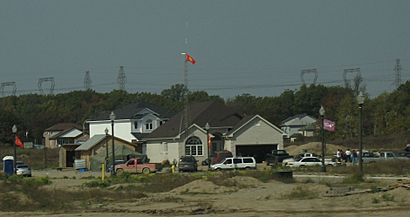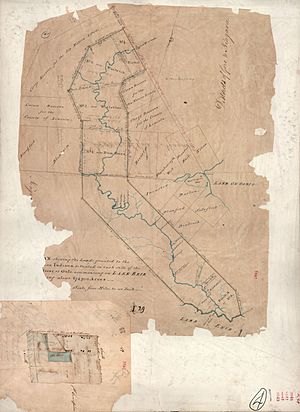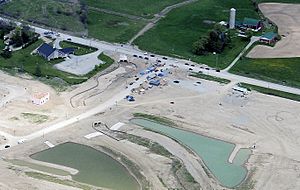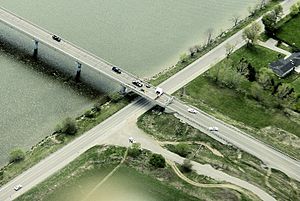Grand River land dispute facts for kids
The Grand River land dispute, also called the Caledonia land dispute, is an ongoing disagreement between the Six Nations of the Grand River and the Government of Canada. It's about a large area of land along the Grand River in Ontario. This land is known as the Haldimand Tract. It's a huge area, about 385,000 hectares (950,000 acres), that was given to Indigenous allies of the British in 1784. This was to make up for land they lost during the American Revolutionary War.
The Six Nations were promised this land forever. However, they say that different Canadian governments have wrongly sold, leased, or given away much of it. Now, only about 5% of the original land is still controlled by the Six Nations. They also claim that money owed to them from leases and loans on this land was never paid or was used by the government instead.
This dispute has been discussed in many formal talks since the 1970s. There have also been protests, blockades, and occupations. Formal talks have stopped, and the dispute is now being handled by the courts. The Canadian government's rule to end Indigenous land rights as part of a settlement is not accepted by the Six Nations. The Six Nations want the money they are owed, ongoing payments for leased lands, and the return of lands that were wrongly transferred.
The dispute became widely known in Canada in 2006. This was when the Six Nations restarted a lawsuit they first began in 1995 against Canada and Ontario. Protesters from the Six Nations of the Grand River demonstrated on a piece of land in Caledonia. This community is in Haldimand County, about 20 kilometers (12 miles) southwest of Hamilton. Soon after, the protesters took control of this land, which was planned for a new housing area called "Douglas Creek Estates." This land, like all of Caledonia, is part of the "Haldimand Tract." The Government of Ontario paid the company that owned the land and stopped the building. They held the land for future talks.
In early 2020, the dispute gained public attention again. Mohawk protesters blocked Highway 6 to support the Wetʼsuwetʼen people. Later, they occupied another planned housing site in Caledonia called "McKenzie Meadows." The protesters named this area "1492 Land Back Lane." They call themselves "land defenders" and have refused to leave, even though an Ontario court ordered them to.
Understanding the Grand River Land Dispute
How the Land Was Granted
The Haldimand Proclamation of 1784
In 1784, Frederick Haldimand bought land along the Grand River from the Mississauga nation. On October 25, 1784, the British Crown gave this land to the Six Nations. This was a thank you for their help during the American Revolution. It was also to replace lands they lost south of the Great Lakes. A group of Haudenosaunee people, led by Brant, decided to settle at the Grand River. Their new shared territory stretched 6 kilometers (3.7 miles) on each side of the Grand River, from its start to where it meets Lake Erie.
Changes to the Land Grant
In 1791, Sir John Johnson noticed a mistake. The northern part of the Haldimand Tract was not within the land bought from the Mississaugas. The Crown's surveyor, Augustus Jones, redrew the boundaries. This included a straight northern line, the Jones Baseline, near where Guelph is now.
In December 1792, the Crown bought the rest of the land up to the Grand River's actual source from the Mississaugas. But they did not give this land to the Six Nations. On January 14, 1793, Lieutenant-Governor John Graves Simcoe confirmed the grant with a limited deed. This was called the Simcoe Patent. It limited the Haldimand Tract to about 111,000 hectares (274,000 acres) for the Six Nations' exclusive use. The rest of the land could be leased or sold by the Haudenosaunee to the Crown. Brant and other Six Nations chiefs rejected this new deed. They said they were not bound by it.
Early Land Sales and Challenges
Sales by Joseph Brant
Around 1796, the Six Nations gave Chief Joseph Brant the power to sell some land. The idea was to invest the money and provide a yearly income for tribal members. They were struggling in their new settlements. The Crown first opposed these sales but later agreed.
From about 1794 to 1796, Joseph Brant began selling land to private buyers. He made a deal that allowed him to sell and lease land if it was offered to the Crown first. He sold about 154,300 hectares (381,480 acres), which was the northern half of the reserve. This brought in a large sum of money, promising a good yearly income.
On February 5, 1798, the land Brant sold to the Crown was divided into six blocks. These were then sold to private land investors. These blocks later became towns:
- Block No. 1 - Township of Dumfries (now North Dumfries and South Dumfries Township)
- Block No. 2 - Waterloo Township
- Block No. 3 - Pilkington Township and Woolwich Township
- Block No. 4 - Nichol Township
- Block No. 5 - Moulton Township
- Block No. 6 - Canborough Township
Challenges in the 1800s
By 1801, all the land investors were behind on their payments. They couldn't sell farm lots fast enough. By 1828, nearly two-thirds of the Grand River territory had been sold, leased, or taken over by people living there without permission.
In 1835, the Crown wanted to develop the Port Dover-Hamilton Plank Road (now Highway 6). The Six Nations agreed to lease land for the road. However, they did not give up ownership of the land. The government later recommended that a reserve of about 8,093 hectares (20,000 acres) be set aside. The rest would be sold or leased to protect it from people moving in without permission.
On January 18, 1841, the Crown claimed the Six Nations council agreed to sell all lands outside the reserve. This was based on the government selling the land and investing the money for them. But on February 4, 1841, the Six Nations protested this. They said the chiefs had been scared and tricked, and they had only agreed to lease the land. More protests followed in July 1841 and 1843. They asked for a larger reserve and to keep certain lands.
The Plank Road was finished in 1843. This helped Caledonia grow but also led to more sales of Six Nations lands. Despite protests, the Crown sold Plank Road lands to others starting in 1845. On May 15, 1848, the land that later became Douglas Creek Estates was sold. In 1850, the Crown set the reserve lands to about 19,000 hectares (47,000 acres), which the Six Nations chiefs agreed to.
Changes in the 20th Century
New Governance and Land Claims
In 1924, the Government of Canada created an elected band government on the Six Nations reserve. This is now known as the Six Nations of the Grand River Elected Council. Some people saw this as a takeover, especially because the Royal Canadian Mounted Police were used to make sure the change happened.
In 1931, the Statute of Westminster was put into effect. This meant the parliament of the United Kingdom could no longer make laws for Canada. All matters concerning Canadian First Nations were now fully under the Canadian Crown.
In 1974, the Six Nations Land Claims Research Office (SNLCRO) was created. Its goal was to follow up on the terms of the Haldimand Proclamation. From 1974 to 1995, the SNLCRO submitted 29 separate land claims. Only one of these was resolved. In 1995, the Government of Canada closed the rest, even those ready for talks. This was because the Six Nations announced they were planning a lawsuit.
Key Land Disputes
Douglas Creek Estates (Kanonhstaton)
Quick facts for kids Douglas Creek Estates occupation |
||||
|---|---|---|---|---|
| Part of indigenous specific land claims in Canada | ||||

An occupied house on the Douglas Creek Estates
|
||||
| Date | February 28 - August 27, 2006 | |||
| Location |
Canada
|
|||
| Caused by | Development of Douglas Creek Estates subdivision near Caledonia, Ontario and Six Nations of the Grand River | |||
| Resulted in | Blockades removed, development halted and land bought by Ontario, protesters allowed to stay, class action lawsuits filed by Caledonia citizens against OPP and provincial government | |||
| Parties to the civil conflict | ||||
|
||||
| Lead figures | ||||
|
||||
| Casualties | ||||
| Injuries | Several, notably Sam Gualtieri | |||
| Arrested | Several | |||
In 1992, Henco Industries Ltd. bought 40 hectares (100 acres) of land for a planned housing area called Douglas Creek Estates. This land was part of an existing land claim by the Six Nations Elected Council. In March 1995, the Six Nations sued the federal and provincial governments. They argued that the land was bought unfairly. The lawsuit was paused in 2004 for talks, but these talks never happened because of the conflict in 2006.
Henco argued that the Six Nations had given up their rights to the land in 1841. They said Henco bought it from the Government of Canada. However, the Six Nations said they never gave up their claim to the land. Their chiefs had protested the 1841 agreement. In July 2005, the plan for Douglas Creek Estates was approved. The province of Ontario guaranteed the land title.
The Occupation of Kanonhstaton
Starting in February 2006, Six Nations community members occupied the site. They named it "Kanonhstaton" in Mohawk, meaning "the protected place." Protesters blocked roads and rail lines. There were also some clashes between protesters and others. The government sometimes stopped talks because of public safety concerns.
On June 12, 2006, over 400 local residents and businesses filed a class-action lawsuit against the Government of Ontario. They claimed the government failed to protect them. This was settled in July 2011, with the government paying $20 million to those affected.
On June 16, 2006, the Government of Ontario announced it had bought the disputed land from the developer. They would hold it until negotiations settled the claim. Talks began but were put on hold in 2009 when the 1995 lawsuit was restarted.
Key Events in 2006
- February 28: Six Nations community members set up tents and a building on the development site.
- March 3: The developer, Henco Industries, gets a court order (injunction) for protesters to leave.
- March 5-6: Protesters burn the court order.
- March 17: A judge orders warrants for arrest if protesters don't leave within five days.
- March 22: Protesters remain, but police do not enforce the order.
- April 4: Hundreds of Caledonia residents gather, demanding the occupation end.
- April 20: Police arrest sixteen people at the site. Later, hundreds of Six Nations people return, and police retreat. Protesters reclaim the site, set up roadblocks, and burn tires and a wooden bridge.
- April 21: Talks begin between the governments and Six Nations leaders. This is the first time the federal government negotiates with the Confederacy Chiefs since 1924.
- April 22: Parties agree to continue talks.
- April 24: About 3,000 Caledonia residents rally against the occupation.
- April 30: The provincial government appoints former premier David Peterson to help negotiate.
- May 19: The Government of Ontario announces it will stop construction on the site indefinitely.
- May 22: Protesters re-establish a barricade across Argyle Street. A truck crashes into a power station, causing a blackout and over $1 million in damage. A state of emergency is declared.
- May 23: Protesters offer to remove their barricade if a counter-barricade by residents is also removed. The road reopens.
- June 9: There are clashes between Six Nations protesters and Caledonia residents.
- June 12: A class-action lawsuit is filed by residents and businesses against the provincial government and police. Premier Dalton McGuinty calls off negotiations due to safety concerns.
- June 15: Negotiations resume after one blockade is removed.
- June 16: The Ontario government buys the disputed site from Henco Industries.
- August 8: A judge orders the Ontario government to stop negotiations until protesters leave the land.
- August 11: The government appeals this ruling.
- August 27: The appeals court rules that protesters can stay on the site and that negotiations can continue.
Police Actions and Lawsuits
Many Caledonia residents complained that police did not protect them from threats and violence during the occupation. David Brown, a resident, claimed he needed a "native-issued passport" to enter his home and was harassed. He sued the police for not protecting his family. Police stated they were trying to find peaceful solutions and that their actions were based on policies for Indigenous protests.
In June 2009, some Caledonia residents formed an unarmed "militia" to enforce laws. Six Nations Councillor Claudine VanEvery-Albert and police spoke against this. In July 2011, a $20 million settlement ended the class-action lawsuit filed by residents and businesses against the government and police.
1492 Land Back Lane (McKenzie Meadows)
| 1492 Land Back Lane | |||
|---|---|---|---|
| Part of indigenous specific land claims in Canada | |||
| Date | July 19, 2020 - present | ||
| Location |
Canada
|
||
| Caused by | Development of McKenzie Meadows subdivision near Caledonia, Ontario and Six Nations of the Grand River | ||
| Status |
|
||
| Parties to the civil conflict | |||
|
|
|||
| Lead figures | |||
|
|||
| Casualties | |||
| Arrested | 37 | ||
| Charged | 52 | ||
McKenzie Meadows was a planned housing project south of Caledonia. Foxgate Development owned the land, about 107 acres (0.43 square kilometers). In 2013, the Six Nations Elected Council asked community members about the project. Most people opposed it. The Grand Council voted not to sign an agreement with the developer.
In 2016 and 2019, the Elected Council of Six Nations received payments and land from the developer. In return, the Elected Council agreed to support the development and not interfere with it. This agreement was signed by Chief Ava Hill in June 2019. However, the Haudenosaunee Confederacy Chiefs Council (HCCC), which represents the traditional government, did not sign it.
The Land Reclamation of 2020
On July 19, 2020, Six Nations community member Skyler Williams and about 20 others walked onto the McKenzie Meadows site. They stopped the construction work and set up a camp. They called it a "reclamation site" and later named it "1492 Land Back Lane." The number 1492 refers to the year Christopher Columbus arrived in the Americas, marking the start of European colonization.
On July 31, 2020, police tried to deliver a court order (injunction) against the protesters. The occupation continued. On August 5, police moved in to enforce the order, arresting nine people, including Skyler Williams. Protesters then set up blockades on roads and the rail line.
On August 7, Haldimand County obtained a second court order to prevent blocking public roads. The people at the site asked for meetings with federal officials. On August 15, the Haudenosaunee Confederacy Chiefs Council supported the land defenders. They said the McKenzie Meadows development was in a "red zone" where no development should happen without their permission. They called for negotiations with the governments.
In August, the federal government offered to restart talks about unresolved land issues. The last blockade near the site was removed on August 22.
Continued Protests and Legal Actions
By early September, a support camp was set up near the main site. This "safety zone" was a meeting place for community members. Several people, including journalists, were arrested for disobeying court orders. The police faced criticism for arresting reporters.
On September 23, Haldimand County's police board asked the police to enforce the injunction more strongly. They called the occupation "acts of terrorism." On October 9, a judge extended the injunctions and ordered occupiers to leave immediately. The judge said, "We cannot be held hostage to violence and threats of violence."
After the October 9 hearing, clashes broke out between police and protesters. This included a flaming barricade and the shutdown of critical infrastructure. The Six Nations Elected Council called the judge's decision "disturbing." They said it showed ongoing systemic racism in Canada.
By November 2020, police had spent millions of dollars on policing the camp. In December, "Tiny Homes" were built at the camp for winter.
Developments in 2021
On January 19, 2021, the land defenders moved their barricade on Argyle Street to allow access to a church and hospitals. This was a sign of good faith. Police did not remove their blockade, saying it would take weeks to repair damage. By January 19, police had spent over $16 million on policing operations.
In February, other barricades were removed, and roads reopened. In June, the head of a toppled statue of Egerton Ryerson was placed at Land Back Lane. This was a symbolic gesture.
On July 2, 2021, the developer of McKenzie Meadows announced the project was officially cancelled. They cited the permanent buildings by land defenders and lack of government help. Mayor Ken Hewitt was disappointed. Skyler Williams, spokesperson for the land defenders, called it a victory. By July 2021, police had spent over $20 million on enforcing the injunctions.
On December 12, 2021, the Ontario Court of Appeal cancelled the injunction against Skyler Williams. They found that the previous judge had not given him a fair chance to respond to allegations. The court awarded Williams $20,000 in damages.
Moratorium on Development
On April 20, 2021, the Haudenosaunee Confederacy Chiefs Council announced a ban on development within the entire Haldimand Tract. They said development should only happen if authorized by the Haudenosaunee Development Institute. They stated they are not interested in selling land but are open to negotiating leases. They urged developers to stop digging and to consult with them.
On April 26, Chief Mark Hill of the Six Nations Elected Council supported the Confederacy's call for a development ban. He emphasized the importance of a united front and the upcoming land claims case in court.
See also
- Iroquois
- Six Nations 40, Ontario
- Indian Register
- Indian Act
- Oka Crisis
- Ipperwash Crisis
- Burnt Church Crisis
- Gustafsen Lake Standoff
- 2020 Canadian pipeline and railway protests
Images for kids








